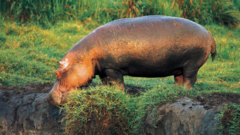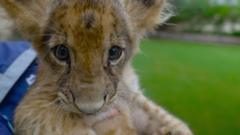At least 50 hippos and various large animals have succumbed to anthrax poisoning in Africa's oldest national park, as reported by park authorities in the Democratic Republic of Congo. Photographic evidence from Virunga National Park shows numerous hippos floating lifelessly in the Ishasha River. The initial sighting of these deceased animals occurred last week. While the precise cause remains unidentified, anthrax has been confirmed through testing. Emmanuel de Merode, the park's director, stated that efforts are underway to recover and bury the corpses to mitigate further spread, although logistical challenges and a lack of excavators complicate the process. "It’s difficult due to lack of access and logistics," he told Reuters, emphasizing a plan to use caustic soda for burial. The Ishasha River leads north toward Lake Edward, another significant body of water in the region, where additional reports of dead wildlife have emerged.
**Anthrax Outbreak Claims Lives of 50 Hippos in Virunga National Park, DR Congo**

**Anthrax Outbreak Claims Lives of 50 Hippos in Virunga National Park, DR Congo**
An outbreak of anthrax has resulted in the shocking deaths of at least 50 hippos and other large animals in Virunga National Park, leading to concerns about public health and wildlife conservation.
Anthrax, caused by the bacterium Bacillus anthracis, poses significant threats, although it is generally not easily transmissible. It often survives as spores in soil for extended periods before infecting animals through inhalation or open wounds. The Congolese Institute for the Conservation of Nature has advised local residents to avoid contact with wildlife and to ensure water from local sources is boiled before consumption.
Spanning approximately 7,800 square kilometers (around 3,000 square miles), Virunga National Park is noted for its rich biodiversity but also for its perilous conditions due to ongoing conflicts involving various rebel factions and the Congolese army. These tensions are fueled by competition for the area's valuable resources, leading to fatalities among rangers who work tirelessly to protect the unique wildlife. Historical efforts to bolster the hippo population, which dwindled from over 20,000 to just a few hundred due to poaching and warfare, underscore the ongoing struggle of wildlife conservation in this tumultuous region.
For more information, visit BBC Africa and stay updated through their social media channels.
Spanning approximately 7,800 square kilometers (around 3,000 square miles), Virunga National Park is noted for its rich biodiversity but also for its perilous conditions due to ongoing conflicts involving various rebel factions and the Congolese army. These tensions are fueled by competition for the area's valuable resources, leading to fatalities among rangers who work tirelessly to protect the unique wildlife. Historical efforts to bolster the hippo population, which dwindled from over 20,000 to just a few hundred due to poaching and warfare, underscore the ongoing struggle of wildlife conservation in this tumultuous region.
For more information, visit BBC Africa and stay updated through their social media channels.
















